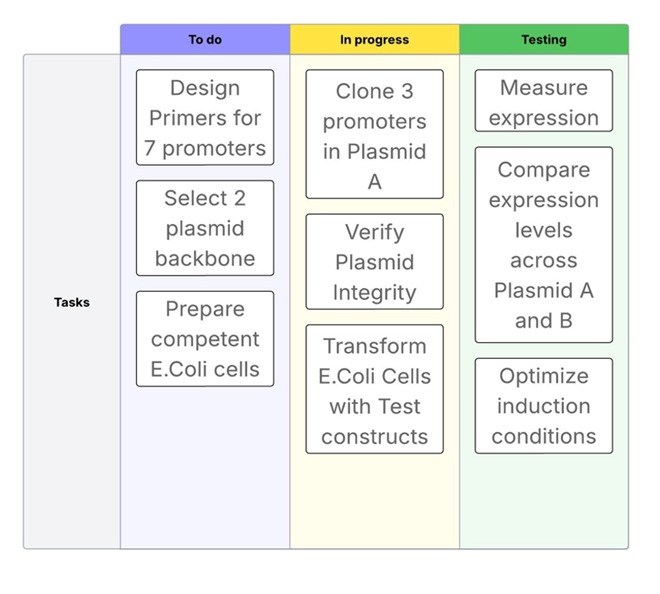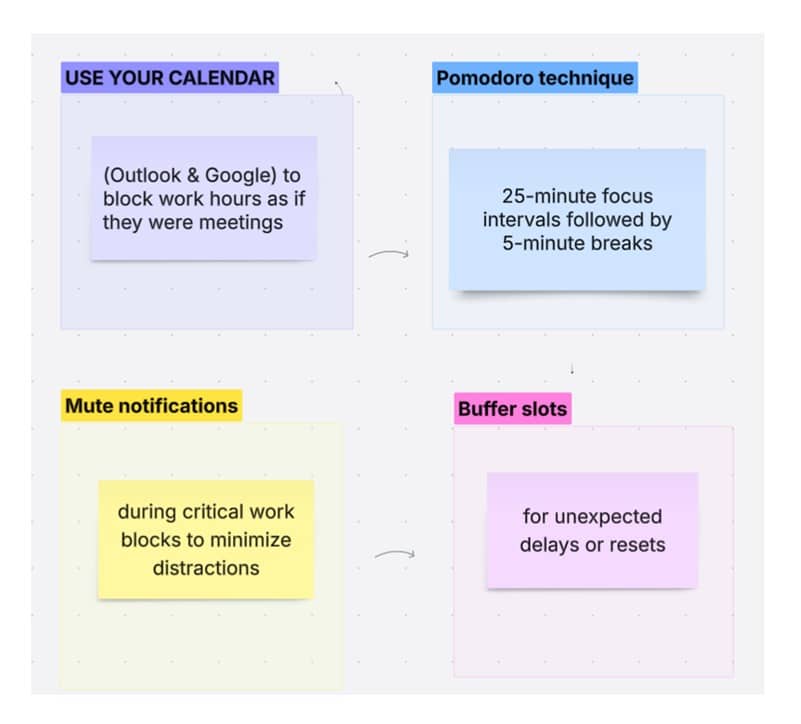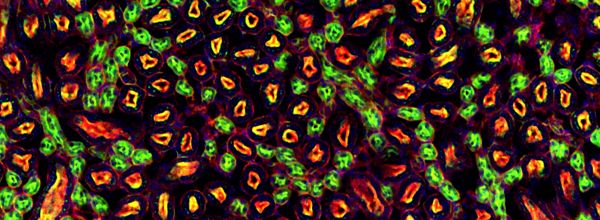Biologists often resemble artisans more than technicians. Whether nurturing cell cultures, fine-tuning instruments, or perfecting protocols, our work demands creativity, precision, and care.
Getting results is not unlike crafting a haute couture gown or building a luxury timepiece—meticulous, high-quality, and often produced in limited quantities.
However, this craftsmanship comes with trade-offs.
Many research groups still struggle with vague timelines, scattered task lists, unclear priorities, and limited visibility into who is doing what, which are all signs of suboptimal project management.
Enjoying this article? Get hard-won lab wisdom like this delivered to your inbox 3x a week.

Join over 65,000 fellow researchers saving time, reducing stress, and seeing their experiments succeed. Unsubscribe anytime.
Next issue goes out tomorrow; don’t miss it.
Iterative progress is often underappreciated, time is misallocated, and important work can fall through the cracks.
This article offers practical, research-specific applications of four Agile tools—iterative experimentation, time boxing, prioritization, and kanban boards—to help you bring structure to chaos, reclaim your time, and amplify the impact of your experiments.
Why Agile Project Management Belongs in Biology Labs
The high cost of vague timelines and unclear supervision, a longstanding issue in academia, only compounds the challenge of conducting effective research.
You’ve likely encountered it: changing expectations, ambiguous goals, and inconsistent guidance. Like many researchers, you may have felt overwhelmed and unsure of your next step.
Despite remarkable advances in scientific tools and technologies, the way research projects are managed has remained largely unchanged for decades.
Many of us PhD students and early-career researchers would agree: the operational models in academic labs often feel frozen in time.
What is Agile Project Management?
This is where Agile offers a compelling alternative. Borrowed from software development, Agile is not just a methodology—it’s a mindset. [1] It promotes iterative progress, rapid feedback, flexibility, and collaboration.
Agile encourages goal clarity, shared ownership, and continuous learning, without sacrificing the creativity, experimentation, and rigor that scientific discovery demands. Here are a few core Agile features that support these outcomes:
- Iterative experimentation encourages small, testable steps with rapid learning loops instead of waiting for a perfect protocol
- Time boxing creates structure for unpredictable research days by assigning fixed windows to high-priority tasks
- Prioritization helps researchers focus on “must-do” experiments while deferring low-impact distractions
- Kanban boards visualize project status across team members and stages, reducing bottlenecks and confusion
- Retrospectives and reviews build a culture of reflection and continuous improvement within lab teams
Through my work with biologists and biotech teams worldwide, I’ve seen that throughput and reproducibility don’t have to come at the expense of innovation and craftsmanship.
Agile can help bridge the gap between the artistic nature of research and the practical needs of scalable, impactful science.
But, for many biologists, Agile may not sound like a new concept at first. In fact, if you’ve ever repeated an experiment to fine-tune a protocol, blocked off a few hours to finish a manuscript, or triaged which of your five tasks actually needs doing today, you’ve already practiced core Agile principles without calling them that.
During my PhD and business analysis education, I discovered how intentionally applying the first four key Agile practices mentioned in the list above improved the clarity and efficiency of my research and bolstered confidence in my data.
I’ve summarized how each of these principles maps to everyday biological research in Table 1 below.
Table 1. Four key Agile project management principles and examples of how they might apply in a biology lab.
[table id=197 /]
Now let’s take a look at each of these in more detail and consider how you could apply them to your research.
1. Iterative Experimentation: Make Progress Even When Results Are Unclear
Science is, by nature, iterative. Rarely does an experiment yield perfect results the first time. You analyze, adjust, and repeat. This is Agile thinking at its core. What Agile adds is intentionality.
Instead of seeing failed experiments as setbacks, they become structured learning loops: test a hypothesis, reflect on feedback, adjust your approach, and move forward.
Take, for example, confocal microscopy to analyze mitochondrial morphology in mammalian cells.
You might begin by staining cells with MitoTracker and running a preliminary scan to test image clarity and laser settings.
After realizing your initial exposure time is too short, you adjust the protocol, repeat staining, and test again, perhaps switching to live-cell imaging or altering your Z-stack parameters.
Rather than waiting for the “perfect” imaging session, Agile encourages small, frequent rounds of testing and adjustment, so you can move forward without bottlenecks. This helps prevent the all-too-familiar trap of overplanning while delivering continuous learning at each step.
Table 2 below illustrates how an iterative approach might look in practice when optimizing a confocal microscopy experiment for mitochondrial imaging. Each cycle builds on the last, capturing small improvements and using them to guide the next step.
Table 2. An example of how an iterative approach applies to a microscopy experiment.
[table id=199 /]
2. Time Boxing: Bring Structure to Your Days
Academic life is filled with shifting demands—grant deadlines, lab meetings, supervisor reviews, and unexpected equipment failures. Without a system to manage these, days can feel reactive and fragmented.
That’s where time boxing comes in. It’s the simple but powerful practice of setting aside fixed blocks of time for specific tasks. [2] For instance, you might dedicate a two-hour block in the morning to sample preparation and mitochondrial staining, and another hour in the afternoon to image analysis, whether or not you finish the full dataset in that time.
Unlike endlessly expanding to-do lists, time boxing creates boundaries and focus. It also helps you identify where time sinks are happening (e.g., troubleshooting the confocal software or redoing slides) and make smarter decisions about your planning.
In Figure 1 and Table 3 below, I have summarized strategies to help researchers implement time boxing more effectively.
Figure 1. Time blocking methods.

Table 3. How you can use time blocking throughout your day.
[table id=200 /]
3. Prioritization using the MoSCoW Method: Focus Your Efforts Where They Matter Most
When everything feels important, it’s easy to get stuck in task paralysis, or worse, spend hours on low-impact work while critical milestones are delayed.
Agile uses prioritization frameworks to keep focus sharp. [3] You might try the MoSCow method, a simple way to separate the must-do tasks from “nice-to-haves”.
In the case of your mitochondrial imaging project:
- A Must – E.g., optimizing staining conditions before your next lab meeting
- A Should – E.g., capturing high-res images for publication figures
- A Could – E.g., testing a secondary marker for co-localization
- A Won’t – E.g., applying AI image segmentation just yet—interesting, but not essential for the current objective
This prioritization ensures that your most impactful tasks come first, and your team isn’t overwhelmed by scope creep or distracted by lower-value work.
4. Kanban boards: Team-wide visibility and tracking
What’s often missing in biology labs is structured visibility—a way to coordinate efforts without micromanagement.
Let’s imagine we’re running a project that involves testing multiple promoters and plasmids in genetically engineered E. coli.
And let’s say your goal is to evaluate seven different promoter-terminator combinations using two plasmid backbones.
This would have many moving parts—primer design, cloning, transformation, and expression analysis. Without a system, tasks can get lost, delayed, or duplicated.
A simple but powerful Agile tool is the Kanban board (see Figure 2 below). [4] This visual task tracker organizes work into the following stages:
- To Do – Tasks that are planned but not yet started
- In Progress – Tasks currently being worked on
- Testing – Tasks undergoing review or validation
By displaying each step, the Kanban board makes work visible and trackable for the entire team.
How to Create a Kanban Board
In the “To Do” column, you might list tasks like:
- Design primers for 7 promoters
- Select 2 plasmid backbones
- Prepare competent E. coli cells
As you begin work, move tasks to “In Progress.”
- Clone 3 promoters into plasmid A
- Verify plasmid B integrity
- Transform E. coli with test constructs
Once experiments are running, they move to “Testing:”
- Measure expression from the promoter library in E. coli
- Compare the expression across plasmid A and B
- Optimize induction conditions
This approach gives you and your team a shared visual reference that improves coordination and prevents bottlenecks. It replaces scattered to-do lists and ambiguous task ownership with a lightweight but effective process.
Figure 2. A simple Kanban board for promoter & plasmid testing in E. coli. (Image credit: Nikunj Sharma.)

Agile in Practice: How You Can Adopt These Four Techniques
Now that you’re familiar with these four concepts of Agile project management, you might
Table 4 below gives you some practical ideas on how you can incorporate them into your research and the outcomes you can expect.
Note that, when trying to adopt Agile principles, it’s worth trying to nail down the problem you are facing, such as “unclear accountability” or “poor progress tracking,” and then choose a technique that will address it.
Table 4. Common issues that delay research, Agile approaches to overcome them, and the outcome you can expect.
[table id=201 /]
Why Agile Principles Work for Researchers
Agile doesn’t demand a complete overhaul of your lab’s workflow. In fact, many researchers already apply its principles informally.
You might already be doing some version of this—and that’s the point.
Agile simply provides a structured, scalable way to do what we already know works, but more consistently and with greater visibility.
Whether you’re balancing multiple experiments, mentoring students, writing papers, or collaborating across departments, these three practices help you focus, adapt, and keep projects moving forward.
In a research environment where ambiguity is common and timelines are rarely fixed, Agile offers a practical response: progress over perfection, clarity over chaos, and structure without rigidity.
Conclusion: Better Project Management for Biologists
Agile project management offers biologists a practical, adaptable way to manage their research, whether you’re testing promoters in E. coli or juggling multiple collaborations and deadlines.
These principles discussed, namely iteration, time boxing, prioritization, and visible workflows using Kanban boards, make progress more transparent, structured, and sustainable.
Best of all, you don’t need to overhaul your lab overnight. It’s important to note that Agile is not limited to the practices discussed here!
For now, the first step is simple: choose one practice, apply it intentionally, and see what changes.
References
- Project Management Institute. Changing and Unchanging Faces of Project Management. Available at: https://www.pmi.org/learning/library/changing-unchanging-faces-project-management-7279. Accessed June 13, 2025
- Clockify. Timeboxing: The Ultimate Productivity Technique. Available at: https://clockify.me/timeboxing. Accessed June 13, 2025
- ProductPlan. Prioritization. Available at: https://www.productplan.com/glossary/prioritization. Accessed June 13, 2025
- Atlassian. Kanban Boards. Available at: https://www.atlassian.com/agile/kanban/boards. Accessed June 13, 2025
Further reading
- Manifesto for Agile Software Development. Available at: https://agilemanifesto.org. Accessed June 13, 2025
You made it to the end—nice work! If you’re the kind of scientist who likes figuring things out without wasting half a day on trial and error, you’ll love our newsletter. Get 3 quick reads a week, packed with hard-won lab wisdom. Join FREE here.







